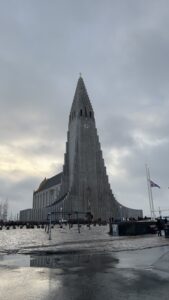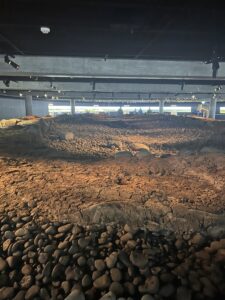Hello everyone, and welcome to my blog! I’m Geoffrey Youngs, a senior at GAC, and I’m thrilled to share my experiences studying abroad in Iceland this January. Currently, we’re on our third full day in Reykjavik, Iceland’s capital city. Today was dedicated to exploring various museums in Reykjavik, providing me with insights into early Icelandic identity and its evolution over time. The museums I visited included Iceland’s House of Collections, The Settlement Exhibition, and The National Museum of Iceland.
The House of Collections museum showcases art representing Icelandic culture, with themed floors such as land and ocean. Unlike many U.S. ski resort towns that capitalize on their land for profit, Icelanders take pride in their unique landscapes, viewing them as more than just a source of income. This perspective is evident in the themes of land and ocean at The House of Collections, as well as on the plane ride over, where screens displayed aspects of Iceland’s nature, emphasizing its significance.
The Settlement Exhibition displays the ruins of a Viking longhouse, offering insights into the simple lifestyle of Viking settlers. The minimalistic approach to living, born out of necessity due to harsh conditions, still prevails in modern-day Iceland. Walking around Reykjavik, I observed three-level housing structures with separate families on each floor, while the families owned nice cars like Teslas or Land Rovers. This is a great display of contemporary modernism that I believe has its roots in Viking culture.
The National Museum of Iceland dedicates an entire floor to Christianity’s role in Icelandic history, underscoring its substantial influence. Although I won’t delve into the details here, it’s noteworthy that Reykjavik boasts the impressive Lutheran church, “Hallgrímskirkja.” The church’s grandeur, along with a museum floor dedicated to Christianity, underscores the significant impact of religion on Icelandic history.
Having highlighted these aspects of Icelandic identity from museums, I’d like to take a moment to address the tourist view of Icelandic identity. Stuffed puffins and polar bears are in almost every tourist shop you’ll see, but puffins are in fact not even native to Iceland and the only time polar bears end up on Iceland is when sheets of ice break off from Greenland and drift over. Tourists here view Viking culture as a masculine, conquering, fearful culture. While in fact, nearly all vikings who settled in Iceland were peaceful farmers. Iceland is occasionally known as “the land of fire and ice”. While this is true given that Iceland is home to glaciers and volcanoes, you have to look for them, they aren’t just everywhere you go. One aspect all these tourist views have in common is that they attract more tourists despite contradicting traditional Icelandic identity.
I’m really intrigued to continue seeing how traditional Icelandic identity and tourist views compare and clash in the next few weeks. Stay tuned for more!
On a side note, I was riding the bus yesterday and observed middle and elementary school kids taking the city bus home and walking home by themselves. This is different than in the U.S., where parents typically pick up or accompany their children. This observation displays the safety and trustworthiness that Icelandic people display.


